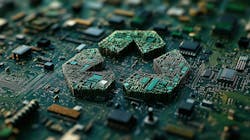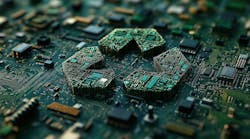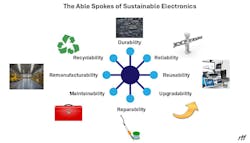What you’ll learn:
- What are the eight general provisions?
- How implementing eco-design brings both similarities and differences between products and components.
- How you can use available tools and methods to help assess and quantify some of the more elusive “-abilities”: dura-, relia-, reusa-, upgrada-, repaira-, maintaina-, remanufactura-, and recyla-, not to mention sustaina-.
The basis for the following discussion is this introductory section of the EU Sustainable Products Regulation.
“Chapter I - General provisions contains these 8 points to consider.
Article 1 Subject matter and scope
(a) product durability and reliability;
(b) product reusability;
(c) product upgradability, reparability, maintenance, and refurbishment;
(d) the presence of substances of concern in products;
(e) product energy and resource efficiency;
(f) recycled content in products;
(g) product remanufacturing and recycling;
(h) products’ carbon and environmental footprints”
Before we can begin to answer “what makes a sustainable component,” a brief definition is in order.
What is a Component?
This Directive is about products. Typical electronic products are made of individual parts, also called components. A component part is generally understood to be:
“An independent physical body that contains the realization of an electronic property or properties and cannot be practicably reduced or subdivided without destroying its function.” — A Dictionary of Electronics and Electrical Engineering (5 ed.)
The difference between the nature of a component and a higher-level assembly of a product is immediately apparent. The inability of a component to be reduced or subdivided without its destruction is important to remember. In each section below, we consider components as well as products.
In the context of sustainability regarding components, a commonly recognized Life Cycle Inventory database, Ecoinvent, lists the following familiar components that have environmental impact data:
- Capacitors: Electrolytic, tantalum, film, SMT
- Resistors: Metal film, wirewound, SMD, potentiometer
- Inductors: Wirewound, RF, choke, multilayer SMT
- Transformers: High and low voltage
- Diodes: Glass, SMT, through-hole, LED
- Transistors: IGBT, SMT, big, small
- ICs: Logic, memory, wafer
- Printed wiring boards: Through-hole, SMT, Pb, Pb-free, used, scrap
- Magnets: Permanent for motors
- Connectors: Cable w/o plug, bus, peripheral, plug for computer/network/printer
Missing at the present time in this database are mechanical items like hardware (bolts, nuts, washers), commonly used metal alloys like brass (although individual metals have data), and most engineering plastics. The other components have at least a representative environmental impact model.
What Does Eco-design Mean for Components?
To help achieve more sustainable products, more sustainable components are key. Next, we go through the requirements one by one, addressing both sides of the challenge.
(a) Durability and reliability
For end equipment to be durable and reliable, its component parts must have at least the same properties or better. Durability in the sense of actual use cases places demands mostly on the end-equipment physical packaging.
Mobile products, for example, should be designed to handle some mechanical shock from accidental dropping. Shipping product packaging must withstand transport, including mechanical shock and vibration. Temperature extremes, thermal shock, and humidity resistance apply to both components and packaging, while protection from other environmental conditions like sand, dust, salt spray, and even vacuum and radiation may need to be considered in equipment design and component selection alike.
>>Download the PDF of this article, and check out the TechXchange for similar articles and videos
Durability testing may be specified to include protocols similar to those available in standards like MIL-STD-202H, TEST METHOD STANDARD ELECTRONIC AND ELECTRICAL COMPONENT PARTS, which can be tailored as appropriate to the end market of a given product, whether high reliability or not.
Reliability can be more precisely defined and measured as a combination of aspects including:
- Probability: The likelihood of mission success
- Intended function: For example, to light, cut, rotate, or heat
- Satisfactory: Perform according to a specification, with an acceptable degree of compliance
- Specific period of time: Minutes, days, months, or number of cycles
- Specified conditions: For example, temperature, speed, or pressure
Reliability can also be predicted and quantified according to standard methods like MIL-HDBK-217F - RELIABILITY PREDICTION OF ELECTRONIC EQUIPMENT. The heart of this method is based on data for components and parts count, including some 22 familiar component types plus a miscellaneous parts category.
(b) Reusability
Examples of reusable components have been around for some time. They include the ability to unplug a part like a vacuum tube or specific frequency crystal, or what had become common practice just a few years ago to remove and reuse memory chips from end-of-life computers.
If an external power supply is considered to be a component (some would argue it’s a module), a very good example of reusability is AC-DC USB chargers and cables using USB connectors. Given some competition in the USB connector choice, with USB-C appearing to be taking over, these supplies are highly reusable across many equipment types.
Complete and functional consumer products may also become reusable, for example, by donating them so that other parties may continue to use what you no longer want or need.
(c) Upgradability, reparability, maintenance, and refurbishment
This item leads to many possibilities. The close relationship between components and end equipment for these aspects of eco-design is clear.
Upgradability could apply to either hardware or software. In the former case, if part of the end product is compatible with a newer or more advanced component or a module, the life of the equipment could be extended. The item being removed for replacement nonetheless needs to be treated according to best practices for circular material recovery.
For software, upgrades are common practice, but it requires that the hardware is compatible with the new code. This dead end has happened to the author when trying to upgrade a PC to the latest operating system, but alas, the hardware was dated and could not handle it.
Repair, maintenance, and refurbishment are all very similar terms that address extending the life of nonfunctional equipment. Repair implies some action that’s needed to restore the equipment in working order, while refurbishment describes rebuilding larger parts of the equipment for the same purpose to extend product life. The option to use brand new or used components may exist as well. Automobile owners will experience one or more of these activities at some point with tires, batteries, fluids, etc.
The key to all of this involves some smaller part of the end equipment being fixed so that the entire equipment doesn’t become end-of-life, but it remains in service.
As with reliability prediction, standard methods of maintainability prediction exist, too, for example, MIL-HDBK-472, MILITARY STANDARDIZATION HANDBOOK: MAINTAINABILITY PREDICTION. This standard begins with a certain amount of “philosophy” (that exact term is actually used several times) followed by guidance to perform analysis and develop a maintainability plan suitable for the equipment under consideration.
Other formal methods, often grouped together as Reliability, Availability, Maintainability, and Safety (RAMS) analysis can be applied to those aspects of circularity for a comprehensive approach. Software tools make RAMS accessible, for example, in this case.
Some precautions for equipment repair at the component level need to be taken during the application of solder heat for moisture sensitive devices to prevent explosive “popcorning.” Refer to the well-established guidance found in IPC J-STD-033D-2018
Handling, Packing, Shipping and Use of Moisture, Reflow, and Process Sensitive Devices.
(d) The presence of substances of concern
Thanks to the reality of several regulations, electronics companies have ready access to lists of such substances:
- EU’s RoHS Directive restricts heavy metals, brominated flame retardants, and phthalate plasticizers.
- EU’s REACH Candidate List controls over 200 Substances of Very High Concern.
- California’s Proposition 65 is yet another list of chemicals, based on risk of exposure.
These substance-related obligations have been detailed elsewhere right here in Electronic Design, so they will not be elaborated again here. Bottom line: Be aware of these substances and design them out of your products. This is sometimes easier said than done, but clearly the intent of this item is to keep hazardous substances from being spread around the world in electronic products.
(e) Energy and resource efficiency
These two aspects may often seem to be unrelated, since the former applies to energy use during manufacturing and transport of the product followed by energy required during the use phase and treatment at end-of-life. While energy may also be considered as a resource, the intent of it is more commonly focused on the material resources used in the component or product.
A clear definition of resource efficiency doesn’t appear to be widely accepted, but it may include such things as:
- The availability of the element or material.
- Ability to be recycled and returned to the stream of commerce.
- Recycled content (see next section).
Manufacturing resource efficiency may be enhanced by:
- Using captive regrind of thermoplastics.
- Reducing part volume and weight.
- Reducing or eliminating factory waste.
- Recycling what little unused assembly materials remain.
Some of these approaches may be applicable to components, especially the trend toward miniaturization that inherently reduces the use of materials.
Component energy efficiency examples include low contact resistance and low energy modes of power-supply ICs and other active components. Product energy efficiency may involve approaches like low standby modes enabled by smart circuits. Overall design strategies to use less energy could result in recognition of, e.g., the ratings promoted for consumer appliances by Energy Star and EPEAT for other electronic products.
(f) Recycled content
Using recycled engineering grade thermoplastics for component applications is unfortunately very rare at this time. Packaging for shipment using recycled consumer plastic or paper content is a positive exception.
Recycled content in many metals, on the other hand, is easily achievable. That’s because copper and its alloys, once collected from end-of-life products, can be refined in metal smelters and continually help reduce the environmental burden of freshly mined ore. Steel is another very common example. Recycled metal specifications for electronics goods, such as ISRI, include very relevant recycling streams for copper and precious metals like circuit boards.
End products are more likely to accommodate larger amounts of recycled plastic, for instance, in housings intentionally sourced from recycling streams. In some products other than large appliances and vehicles, most of the metal content of end products comes from its components and circuit boards.
(g) Remanufacturing and recycling
Remanufacturing applies mainly to products, such as replacing defective components and reassembling the product like it was manufactured in the first place.
Recycling can be optimized for products if some of the larger mechanical parts, like housings made of separable, single materials, are sent for recycling and the product is remanufactured with new housings.
It’s somewhat more difficult to say how most of the components listed above could practically and economically be remanufactured. A basic requirement of a component is that it be an entity with functionality all by itself, almost always requiring some electrical conductor (metal or filled, conductive material) or semiconductor (silicon, gallium arsenide, etc.) and insulator (resin or ceramic).
The state of the art today for component recycling generally involves size reduction and shredding to recover the metals and some fillers such as glass that may be recoverable. Creating sustainable components that resolve these basic conflicting requirements should be a challenge for today’s students and applied in tomorrow’s sustainable component industries. We have proposed that more carbon-based components may help solve some of this puzzle.
(h) Carbon and environmental footprints
The output calculations of a Life Cycle Assessment may include one or more environmental footprint metrics. One of the current hot metrics is carbon footprint, which may include the carbon footprint of raw materials and fabrication, including component and/or product manufacturing and transportation, to put on the market. These steps comprise a Cradle to Gate scope.
Adding the use phase and end-of-life recovery phases widens the scope considerably for energy using products like electronics (not to mention those like vehicles again that consume fuel of one kind or another) to a truly circular Cradle to Grave, or better yet, Cradle back to Cradle circular life. Reducing the carbon footprint of components may include:
- Reduced footprint material selection.
- Using locally sourced materials.
- More energy-efficient manufacturing.
- Factories that use renewable energy rather than fossil fuels.
Conclusions
The challenges of eco-design for electronic products lay before us, with many of the “-abilities” yet to be fully realized in most components. Novel approaches to components that were designed in the vacuum tube era and adapted to through-hole then surface-mount assembly are still largely a dream. Only with awareness will change be possible. Let us know how you’re doing.
>>Download the PDF of this article, and check out the TechXchange for similar articles and videos
About the Author
Roger L. Franz
Environmental Sustainability Advocate and Contributing Author
Roger Franz has served as Principal, Engineering IT at TE Connectivity, Research Engineer at UL Environment, and Group Leader and Design for Environment Manager at Motorola. In addition to product environmental compliance and standards, his passions include new product development, quality, and technology research. His papers have appeared in several industry journals. He has had over a dozen article published in Electronic Design. He holds a BA and MS in chemistry from Grinnell College and Northwestern University, respectively.



